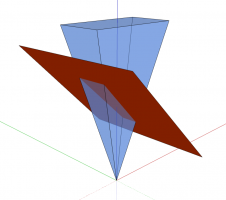Hi All,
I'm trying to source a set of equations to calculate the x,y,z of where an angled plane intersects an oblique rectangular pyramid.
The pyramid has the following coordinates:
Centre of oblique rectangular pyramid: 70,35,350
Corner #1: 100,50,350
Corner #2: 100,-50,350
Corner #3: -100,-50,350
Corner #4: -100,50,350
Apex: 0,0,0
The angled plane is hinged at 0,0,175 and can tilt and roll. Assuming it's boundaries extend out well beyond the pyramid, it's dimensions are irrelavent.
Firstly, how can I calculate the intersecting coordinates (x,y,z) of the two shapes if the angled plane only tilts (for example to an angle of 45 degrees)?
Secondly, how can I calculate the intersecting coordinates (x,y,z) of the two shapes if the the angled can both tilt (45 degrees) and roll (for example 10 degrees)?
I've attached two example images to help better visualise what I'm trying to achieve.
Please could I request that anybody able to help not only provide the formula for this but also apply it using the able values so I can be sure to understand it.
A massive thanks in advance to anybody able to assist.
Regards
ANDJO
I'm trying to source a set of equations to calculate the x,y,z of where an angled plane intersects an oblique rectangular pyramid.
The pyramid has the following coordinates:
Centre of oblique rectangular pyramid: 70,35,350
Corner #1: 100,50,350
Corner #2: 100,-50,350
Corner #3: -100,-50,350
Corner #4: -100,50,350
Apex: 0,0,0
The angled plane is hinged at 0,0,175 and can tilt and roll. Assuming it's boundaries extend out well beyond the pyramid, it's dimensions are irrelavent.
Firstly, how can I calculate the intersecting coordinates (x,y,z) of the two shapes if the angled plane only tilts (for example to an angle of 45 degrees)?
Secondly, how can I calculate the intersecting coordinates (x,y,z) of the two shapes if the the angled can both tilt (45 degrees) and roll (for example 10 degrees)?
I've attached two example images to help better visualise what I'm trying to achieve.
Please could I request that anybody able to help not only provide the formula for this but also apply it using the able values so I can be sure to understand it.
A massive thanks in advance to anybody able to assist.
Regards
ANDJO


